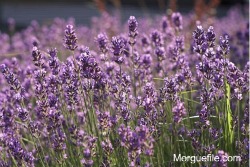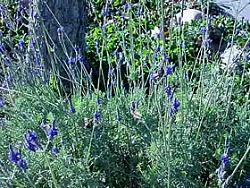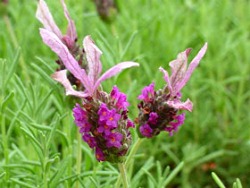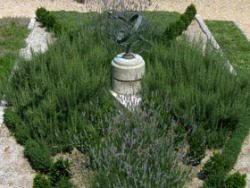
Fields of lavender offer beauty and fragrance. Lavender flowers are great dried and used to make teas, in cooking and perfumes.

English lavender is the most common and hardiest of all lavenders. 'Munstead' is a good variety to try in cold climates.
Lavender has one of the richest and most lavish histories. This Mediterranean herb has been found in Egyptian tombs and was extensively used by the ancient Greeks and Romans for a variety of purposes. Lavender was recognized early on for its healing properties. It has been used to clean and heal wounds, relieve headaches, soothe skin burns, and calm upset stomachs. The sweet scent was favored to clean the air of unpleasant odors and provide a perfume for clothing and bodies.
Royalty in France and England favored lavender, and it became widely popular even among the common people. Small bags were filled with dried lavender flowers to store in wardrobes and under pillows. It was used to repel lice and mosquitoes. Today, teas and oils are used in perfumes and medicinally to help with depression, sleep disorders, headaches, fatigue, and tension. You'll even find lavender in foods such as chocolates, adding a unique taste. While originating in Europe, lavender is now grown around the world.
In the home garden, the obvious place to grow this multi-faceted plant is in the herb garden. However, gardeners in USDA zone 8 and warmer climates can also use lavender as a landscape plant mixed with other perennial flowers, small shrubs, or around small trees. The beautiful gray-green foliage and colorful flowers work to make this perennial herb an attractive landscape feature.
PlanningLavender grows best in full sun on well drained soil. While the widest selection of lavender plants can be grow in USDA zone 8 to 11 gardens, there are varieties that will survive even a USDA zone 4 winter with protection. Most bloom in spring and early summer and are a favorite among honey bees and other insects. The most popular type of lavender is common or English lavender (Lavandula angustifolia). This evergreen has purple, pink, or white flowers, depending on the variety; a strong fragrance; can grow to 3 feet tall and wide; is hardy in zones 5 to 11; and is used in the cosmetics and perfume industries. It grows best under cool, dry conditions.
French lavender (Lavandula dentata) doesn't have the strong scent of English lavender, and the flower colors are more muted. It's hardy in zones 8 to 11 and is used mostly for decorative purposes. Spanish lavender (Lavandula stoechys) features unique purple flowers in spring. The upright, pine-cone shaped, flower bracts have a stunning appearance on this 2 foot tall and wide shrub that is hardy in zones 8 to 11. The piney fragrance is strong, so it's not commonly used in cooking.
Yellow lavender (Lavandula viridis) features a strong fragrance, bold yellow flowers, and yellow green foliage. It also is hardy in zones 8 to 11. Spike lavender (Lavandula latifolia) is a coarser looking plant, but has up to three times the oil content of regular lavender. It's mostly used in making soaps, deodorants, and disinfectants. Lavandin (Lavandula x intermedia) is a Dutch hybrid that's a cross between common lavender and spike lavender. It has the beauty of English lavender plants with a similar oil content of spike lavender. Spike and lavandin lavenders are a little less hardy than English lavender, but are more heat and drought tolerant.
There are many varieties of these lavenders you can grow, depending on your location. Here are a few to consider.
'Goodwin Creek Gray'' – This French hybrid lavender features a 2 foot tall and wide plant with purple flowers and hardiness to zone 7. It makes a great edging plant along a flower border.
'Munstead' – Considered one of the hardiness varieties of English lavender, it grows 12 to 18 inches tall and wide, has purple flowers and is hardy to zone 4 with protection.
'Hidcote' – Smaller than the 'Munstead' lavender, this English variety grows best in cooler weather. There is also a pink version available.
'Kew Red' – This Spanish lavender features unique pink and cerise-colored flowers with gray-green foliage. It grows to 2 feet tall and wide and is hardy in zones 7 to 9.
'Grosso' – A lavandin hybrid, this variety grows 30 inches tall and wide with violet flowers and a strong scent.
PreparationHailing from the Mediterranean, lavender loves full sun and well-drained soil. Depending on the type, lavender grows best in cool or hot conditions. Amend the soil before planting with compost and keep the pH between 6.5 and 7.5. Lavender doesn't grow well on acidic soils. It's best to start with purchased lavender plants. Some English varieties such as 'Munstead' and 'Hidcote', can be started from seed, but germination is slow and erratic at best.
Planting
Spanish lavender has unique brachts on the tops of the flowers. Some varieties feature red colored flowers as well.

Lavender can be grown by itself in the landscape or used in a formal herb herb with other stately herbs such as rosemary.
Plant in spring in most areas. Space plants at the same width as their ultimate height. Full sun is important for the plants to fill out well. However, in hot summer areas, some afternoon shade may be appreciated. It's important to properly space lavenders, especially in humid summer areas, to avoid diseases and dieback. If growing in a potentially wet summer region or on heavy soils, consider planting lavender on a raised bed to make it more likely to survive. Lavender also grows well in containers, as long as the pots are protected over the winter in cold areas.
CareIf grown on properly prepared soil, lavenders need little additional fertilization. Plants will take up to three years to become fully established, so it's important to keep them well weeded. Even though lavender is drought tolerant, keeping the soil moist during the early years is also important.
Once established, prune lavenders annually, removing up to one-third of the foliage after flowering. This is important to rejuvenate the shrub and keep it bushy. However, don't prune back into the old woody growth or it may set back the bush and even kill it.
Lavenders have few insect problems, and the only diseases that can become troublesome are related to poor soil water drainage, such as root rot. Also, plants that are overcrowded can get fungal leaf diseases such as powdery mildew. Properly space plants and encourage air flow to avoid these diseases.
HarvestHarvest lavender flowers for drying when they are from one-third to fully open. Purple colored varieties dry best, while pink or white colored flowers lose their luster when dried. They're still good additions to sachets and potpourris. Harvest after the dew has dried on a sunny day. Cut flower stems longer if using them as a cut flower.
Hang flower stems in a cool, airy, shaded room to dry naturally. Dried buds and flowers are great in potpourris and sachets. Use flowers and buds only in cooking and teas since the leaves may be too strongly flavored.
Other information on lavender:Lavender
Purple Haze Craze
Lavender Production
 Charlie Nardozzi is an award winning, nationally recognized garden writer, speaker, radio, and television personality. He has worked for more than 30 years bringing expert gardening information to home gardeners through radio, television, talks, tours, on-line, and the printed page. Charlie delights in making gardening information simple, easy, fun and accessible to everyone. He's the author of 6 books, has three radio shows in New England and a TV show. He leads Garden Tours around the world and consults with organizations and companies about gardening programs. See more about him at Gardening With Charlie.
Charlie Nardozzi is an award winning, nationally recognized garden writer, speaker, radio, and television personality. He has worked for more than 30 years bringing expert gardening information to home gardeners through radio, television, talks, tours, on-line, and the printed page. Charlie delights in making gardening information simple, easy, fun and accessible to everyone. He's the author of 6 books, has three radio shows in New England and a TV show. He leads Garden Tours around the world and consults with organizations and companies about gardening programs. See more about him at Gardening With Charlie.
 Victory Seed Company has all the seeds you want for your best garden in 2024.
Victory Seed Company has all the seeds you want for your best garden in 2024.
For 25 years, the family-owned Victory Seed Company has provided the highest quality vegetable, herb and flower seeds to families across the country. We are passionate about providing you the best seeds available that give excellent germination, robust plants, and the harvest you want. With a catalog of over a thousand varieties, we have everything, and our prices are the kinds that we'd want to pay. We have hundreds of yesterday's heirloom vegetables, as well as today's award winning hybrid selections. Get to know us by visiting our website and browsing through our online vegetable seed catalog.